By Anupum Pant
Warning: I like to boast in public because it helps me stick to my resolutions better. Following is a paragraph that brags a bit, so please understand…
Phew! It’s been 179 days since I started this website and there isn’t a single day I’ve missed writing something here. Some days the articles were good, other days they were awful. Good or not, at least I slept a little smarter everyday. As a result, I have documented 179 good pieces. You can check them in the archives right now. Be my guest and since it is sunday, take some time to read through some of them, find mistakes, comment etc.This, thankfully, is the 180th article that is being written on the 180th day. That’s pretty huge for me. I’ve never done something this big ever in my life before. Trust me, it is a very tough commitment. If you wish to, acknowledge it in the comments. It will mean a lot to me.
However, today due to some other important work, my article writing ritual got delayed (happens a lot), and now it’s more than an hour past midnight. Thanks to my public boasting, I will still have to keep up. No sleeping before I write something. Or, I will simply have to get shamed in public (if someone even keeps a track of my progress). Probably my sleep will have to suffer today. So I thought, to sleep efficiently, let me learn a bit about sleep!
59 Seconds again!
And as always, the YouTube channel 59 seconds came to my rescue. I love the channel so much, I’ve mentioned it in at least 5 different posts before.
Anyway, the host, Richard Wiseman has a new book in the market – Night School: Wake up to the power of sleep. It talks about the science of sleep. Whenever he has a new book, there are a few interesting videos that come up on his channel that share a very cool tidbit from the book. The book is definitely on my read list, but will have to do with a related video for now.
World’s Most Relaxing Music
One of the videos this time is one hour-long and plays a scientifically constructed music that according to the professor is the world’s most relaxing piece of music. If you keep playing it in the background while sleeping, it will help you sleep better. I’ve tried this one when I took a nap in the afternoon one day. I can vouch for it. I actually had a very relaxing nap that time.
The tune is especially relaxing because, with a 90 BPM tempo and notes moving from low to high, it is scientifically designed to help you fall asleep. Here is the piece. Play it and have a good sleep.
While this would help me fall asleep, tonight I won’t have a problem with falling asleep. As I’m tired, I’d fall asleep easily. What I’m worried about is that I might get less sleep (it really doesn’t matter, I can just wake up late tomorrow). So, here is something from the same channel that, even with a shorter sleep span, would probably help me wake up happier tomorrow.
The 90-Minute rule
During our sleep, we have these cycles where our brain takes us from light sleep to deep sleep and then to a dream state. These three states make one cycle and it takes about 90 minutes to complete a cycle. If you happen to wake in the middle of a cycle, you’d wake up cranky. The trick to waking up happier is to wake up when one of this cycles is complete. There are of course apps on the Play store that help you achieve that, but I don’t have an android phone. So here is what I can do.
I can plan an alarm in a way that I complete several 90 minute cycles and wake up at the end of the last cycle. For that, if I plan to fall asleep at 2:30 AM, to complete a fair 6 hour sleep, I’d have to put an alarm for 8:30 AM. At 8:30, I’d have completed 4 cycles.
Except that these cycles don’t last for exactly 90 minutes. Some times they are more than that, other times they last for a lesser time. Still, by measuring my sleep period in 90 minute chunks, I can increase the probability of me waking up happier. Here is the video where Richard explains this…
Hit like if you learnt something today.













